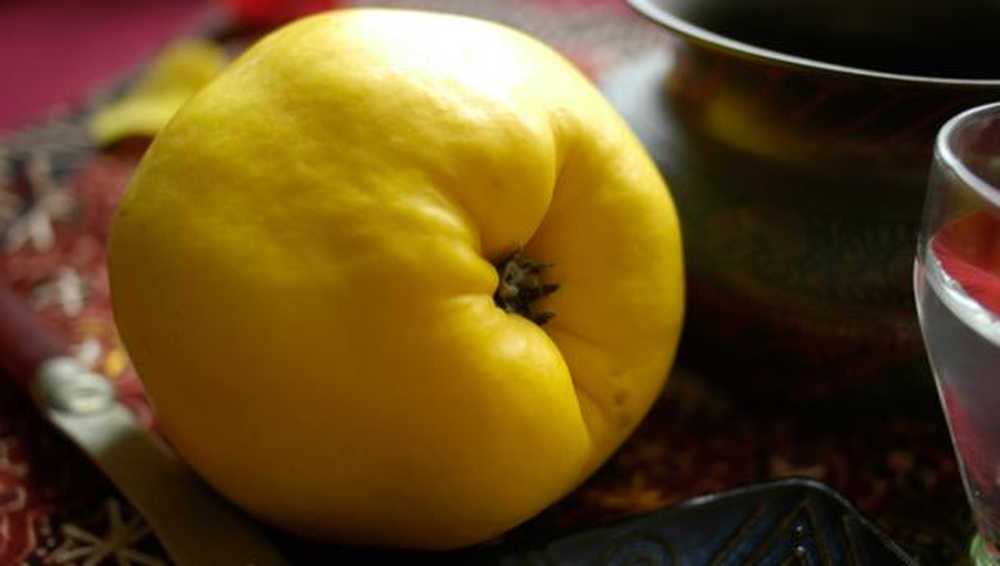Quince - In Season

The new books highlighted by Darina Allen in her column this month include Gather, by Gill Meller (Quadrille, £25) and, from it, she selected the lovely recipe for pheasant and quince, given below.
“Look out for quince, they are in season at present,” she says. “You’ll find them in good greengrocers and at some Farmers Markets. A bright canary yellow fruit that resembles a slightly knobbly pear. They are deliciously perfumed and can have a downy fur on the outside. The fruit is always hard even when fully ripe. Use to make homemade membrillo - quince cheese or quince jam, delicious for Christmas presents or adds cubes of quince to pork or lamb stews or tagines. Alternatively give a quince tree to a foodie gardening friend, (cydonia oblonga) - a gift for life.”

RECIPE: Gill Meller’s Fried Pheasant with Quince and Bay
From Gather, by Gill Meller (Quadrille, £25)
This rustic dish has an air of autumn about it. I like to think it’s got all the colour and patina of a hedgerow as its greens turn to soft, mottled yellows and light, earthy browns. The first pheasant of the season usually coincides nicely with the quince harvest.
You can prepare the quince well in advance – once cooled, it keeps beautifully in the fridge in its cooking syrup. If you’re not having pheasant, you can just as easily serve the quince alongside some good cheese and cold ham, or enjoy it sweet – with vanilla icecream.
Serves 2
Pared zest of ½ lemon
8 black peppercorns
2 bay leaves
1 teaspoon fennel seeds (optional)
2 thyme sprigs
75 g (2½ oz) sugar
2 tablespoons runny honey
2 quinces, peeled, quartered and cored
1 tablespoon extra-virgin olive oil
75 g (2½ oz) unsmoked bacon lardons
2 pheasant or guinea fowl breasts (about 150 g/2½ oz) each)
1 knob of butter
Salt and freshly ground black pepper
First, make the fragrant syrup. Place the lemon zest, peppercorns, bay leaves, fennel seeds (if using), thyme sprigs, sugar, honey and 300 ml/10½ fl oz of water in a medium pan. Place the pan over a medium heat and bring up to a gentle simmer.
Cut each quince quarter into 2 or 3 more evenly sized wedges. Place the wedges into the simmering syrup and cook very gently for 25-45 minutes, until the wedges are tender. (The cooking time can vary from quince to quince). When the quince are ready, remove from the heat, then use a slotted spoon to take them out of the pan and set aside.
Heat the olive oil in a large frying pan over a medium heat. Add the lardons and fry, stirring regularly, for 4-6 minutes or until the lardons are beginning to colour a little. Season the pheasant or guinea fowl breasts with salt and pepper and add them to the pan together with the cooked quince.
Cook the breasts for 2-3 minutes on each side, or until golden brown and cooked to your liking, and until the quince wedges are lightly caramelised. Remove the pan from the heat, then remove the breasts from the pan and set aside to rest.
Divide the lardons and quince wedges equally between two warmed plates. Then place the frying pan over a high heat and add 100 ml (3½ fl oz) of the fragrant syrup (save the rest to use a fruit syrup). Reduce this by half; take the pan off the heat and stir in the butter until melted; season to taste.
Cut each breast into thick slices and divide it equally between the two plates, arranging it next to the quince. Spoon over the syrup and serve straight away.
Gather by Gill Meller (Quadrille, £25)






There are currently no comments
Leave a comment
Not a member? Register for your free membership now!
Or leave a comment by logging in with: